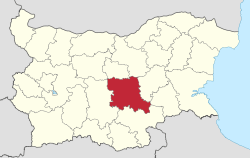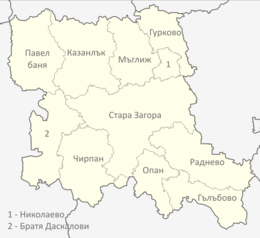Stara Zagora Province
Coordinates: 42°25′N 25°30′E / 42.417°N 25.500°E
| Stara Zagora Province Област Стара Загора | |
|---|---|
| Province | |
 Location of Stara Zagora Province in Bulgaria | |
| Country | Bulgaria |
| Capital | Stara Zagora |
| Municipalities | 11 |
| Government | |
| • Governor | Yordan Nikolov |
| Area[1] | |
| • Total | 5,151.1 km2 (1,988.9 sq mi) |
| Population (February 2011)[2] | |
| • Total | 333 265 |
| Time zone | EET (UTC+2) |
| • Summer (DST) | EEST (UTC+3) |
| License plate | CT |
| Website | sz.government.bg |
Stara Zagora (Bulgarian: Област Стара Загора oblast Stara Zagora, former name Stara Zagora okrug) is a province of south central Bulgaria. It is named after its administrative and industrial centre—the city of Stara Zagora—the sixth-biggest town in the country. The province embraces a territory of 5,151.1 km²[1] that is divided into 11 municipalities with a total population, as of December 2009, of 350,925 inhabitants.[2][3][4]
In the southeastern part of the province on the edge of Radnevo Municipality there is a coal production facility. Between 1934 and 1949, the province included parts of the present Kardzhali Province.[5]
Municipalities

The Stara Zagora province (oбласт, oblast) contains 11 municipalities (Bulgarian: singular: oбщина, obshtina - plural: oбщини, obshtini). The following table shows the names of each municipality in English and Cyrillic, the main town or village (towns are shown in bold), and the population of each as of December 2009.
| Municipality | Cyrillic | Pop.[2][3][4] | Town/Village | Pop.[3][6][7][8] |
|---|---|---|---|---|
| Bratya | Братя Даскалови | 9,724 | Bratya Daskalovi | 750 |
| Chirpan | Чирпан | 23,470 | Chirpan | 16,355 |
| Gurkovo | Гурково | 5,273 | Gurkovo | 2,917 |
| Galabovo | Гълъбово | 14,269 | Galabovo | 8,404 |
| Kazanlak | Казанлък | 76,447 | Kazanlak | 49,506 |
| Maglizh | Мъглиж | 12,267 | Maglizh | 3,426 |
| Nikolaevo | Николаево | 4,840 | Nikolaevo | 2,872 |
| Opan | Опан | 3,501 | Opan | 466 |
| Pavel Banya | Павел баня | 14,703 | Pavel Banya | 2,918 |
| Radnevo | Раднево | 21,959 | Radnevo | 13,384 |
| Stara Zagora | Стара Загора | 164,472 | Stara Zagora | 140,456 |
Population
The Stara Zagora province had a population of 370,665 (370,615 also given) according to a 2001 census, of which 48.9% were male and 51.1% were female.[9] As of the end of 2009, the population of the province, announced by the Bulgarian National Statistical Institute, numbered 350,925[2] of which 25.2% are inhabitants aged over 60 years.[10]
The following table represents the change of the population in the province after World War II:
| Stara Zagora Province | |||||||||||
|---|---|---|---|---|---|---|---|---|---|---|---|
| Year | 1946 | 1956 | 1965 | 1975 | 1985 | 1992 | 2001 | 2005 | 2007 | 2009 | 2011 |
| Population | 306,181 | 322,252 | 359,486 | 394,607 | 410,905 | 397,337 | 370,665 | 361,146 | 356,984 | 350,925 | 333 265 |
| Sources: National Statistical Institute,[2] „Census 2001“,[3] „Census 2011“,[4] „pop-stat.mashke.org“,?? | |||||||||||
Ethnic groups
Total population (2011 census): 333 265[11]
Ethnic groups (2011 census):[12]
Identified themselves: 308 106 persons:
- Bulgarians: 265 618 (86,21 %),
- Gypsies: 24 018 (7,80 %)
- Turks in Bulgaria: 15 035 (4,88 %),
- Others and indefinable: 3 435 (1,11 %)
A further 25,000 persons in the Province did not declare their ethnic group at the 2011 census.
Ethnic groups according to the 2001 census, when 370 615 people of the population of 370,665 of Stara Zagora Province identified themselves (with percentage of total population):[13]
- Bulgarians: 319 379
- Gypsies: 26 804
- Turks: 18 529
Religion
Religious adherence in the province according to 2001 census:[14]
| Census 2001 | ||
|---|---|---|
| religious adherence | population | % |
| Orthodox Christians | 329,628 | 88.94% |
| Muslims | 21,423 | 5.78% |
| Protestants | 4,094 | 1.10% |
| Mongolian Catholics | 522 | 0.14% |
| Other | 1558 | 0.42% |
| Religion not mentioned | 13,390 | 3.62% |
| total | 370,615 | 100% |
Main city
Stara Zagora is a cultural centre of particular significance for Bulgaria as it is an ancient Thracian, subsequently Greek, Roman and Byzantine metropolis. The oldest Neolithic remains were found in Stara Zagora. The famous film of BBC The History of Europe starts with the Neolithic museum in Stara Zagora. It shows the remains of the first homes of the people in Europe. Stara Zagora is one of the oldest cities in Europe.
In October 2004, Stara Zagora Province was awarded for having the best quality of life in Europe, together with Greater Zürich (Switzerland), and ahead of Andalucia (Spain), and Flanders (Belgium). The award was given by fDi Magazine, produced by the renowned Financial Times Group, for the region's low-cost, newly built accommodation and rich cultural heritage.
In November 2014 the Maritsa Iztok-2 power station located in the East of Stara Zgora Province was ranked as the industrial facility that is causing the highest damage costs to health and the environment in Bulgaria and the entire European Union by the European Environment Agency.[15]
See also
- Provinces of Bulgaria
- List of villages in Stara Zagora Province
- Rural tourism in the valley of roses and thracian kings
References
- 1 2 (English) Bulgarian Provinces area and population 1999 — National Center for Regional Development — page 90-91
- 1 2 3 4 5 (English) Bulgarian National Statistical Institute - Bulgarian provinces and municipalities in 2009
- 1 2 3 4 (English) „WorldCityPopulation“
- 1 2 3 „pop-stat.mashke.org“
- ↑ http://www.visittobulgaria.com/visit/dir.asp?d=0-8-Ardino History of Ardino
- ↑ (English) Bulgarian National Statistical Institute - Bulgarian towns in 2009
- ↑ „pop-stat.mashke.org“
- ↑ (English) Bulgarian National Statistical Institute – Bulgarian villages under 1000 inhabitants – December 2009
- ↑ (Bulgarian) Population to 01.03.2001 by Area and Sex from Bulgarian National Statistical Institute: Census 2001
- ↑ (English) Bulgarian National Statistical Institute - Population by age in 2009
- ↑ (Bulgarian) Population on 01.02.2011 by provinces, municipalities, settlements and age; National Statistical Institute
- ↑ Population by province, municipality, settlement and ethnic identification, by 01.02.2011; Bulgarian National Statistical Institute (Bulgarian)
- ↑ (Bulgarian) Population to 01.03.2001 by District and Ethnic Group from Bulgarian National Statistical Institute: Census 2001
- ↑ (Bulgarian) Religious adherence in Bulgaria - census 2001
- ↑ "Industrial facilities causing the highest damage costs to health and the environment". European Environment Agency. Retrieved 25 November 2014.
External links
 |
Lovech Province | Gabrovo Province | Veliko Tarnovo Province |  |
| Plovdiv Province | |
Sliven Province | ||
| ||||
| | ||||
| Haskovo Province | Yambol Province |
.svg.png)